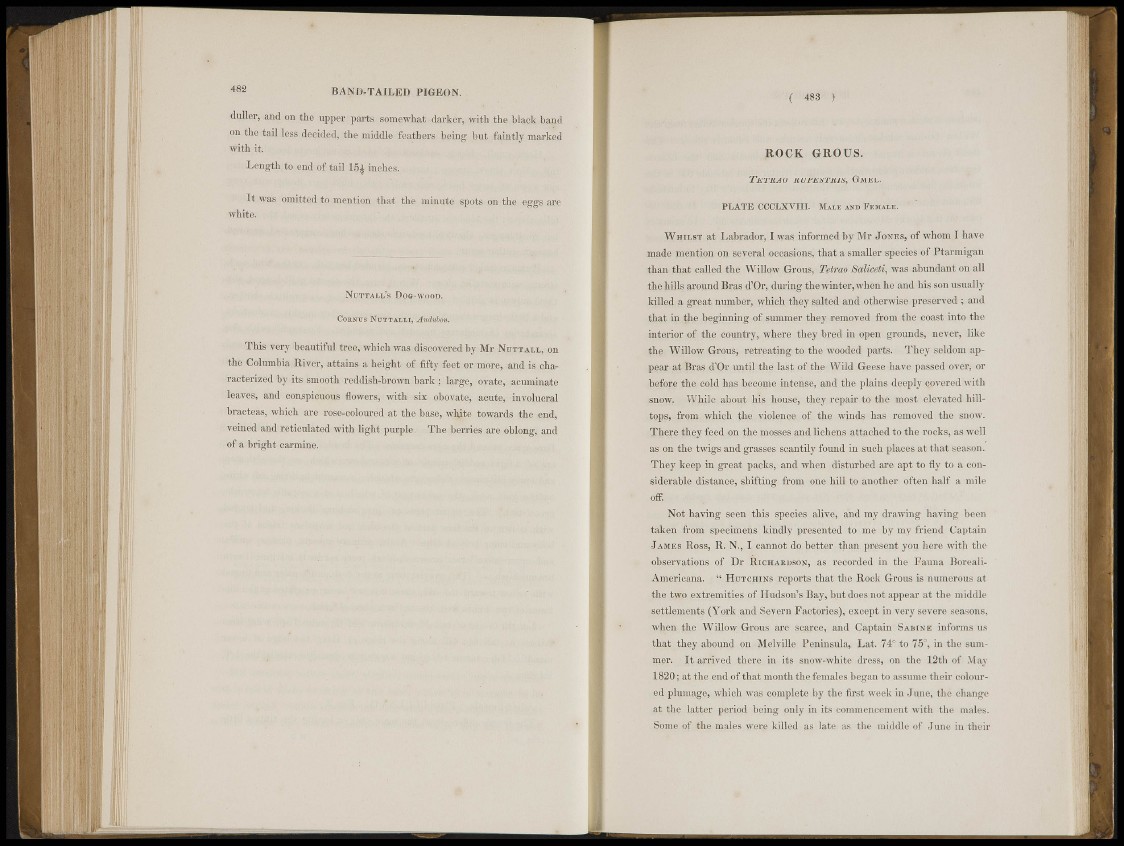
482 B A H D R T A I L E D PIGKON.
duller, and on the upper parts «imiowhal darker, with the black hum!
"" less decided, the middle feathers being but family marked
with it;!' .
: .r.«Tigtb,ti)f(.|i(l of tail 15| inches.
I t was omitted-to mention that the -rninuto spots on tho eggs are;
white. .'-)
NuTTAiLp's l)o<j-w>oi>.
G>ma:s NUTTAI.!.!, Anjylon.
This very beautiful tree, which, was discovered by Mr NUTTALL, on
the Columbia,,River, attains a height of fifty feet or more, and is characterized
'by its smooth reddish-brown bark ; large, ovate, acuminate
leaves, and conspicuous flowers, with six obovate, acute, involucral
bracteas, which are rose-coloured at the base, white towards the end,
veined and reticulated with light purple The berries are oblong, and
of a bright carmine.
( 4S3 )
R O C K GROUS.
TETRAO RUPESTRIS, GMEL.
PLATE CCCLXYIII. MALE AND FEMALE.
W H I L S T at Labrador, I was informed by Mr JONES, of whom I have
made mention on several occasions, that a smaller species of Ptarmigan
than that called the Willow Grous, Tetrao SaUceti, was abundant on all
the hills around Bras d'Or, during the winter, when he and his son usually
killefl a great number, which they salted and otherwise preserved ; and
that in the beginning of summer they removed from the coast into the
interior of the country, where they bred in open grounds, never, like
the Willow Grous, retreating to the wooded parts. They seldom appear
at Bras d'Or u^til the last of the Wild Geese have passed over, or
before the cold has become intense, and the plains deeply Covered with
snow. While about his house, they repair to the most elevated hilltops,
from which £he violence of the winds has removed the snow.
There they feed on the mosses and lichens attached to the rocks, as well
as on the twigs and grasses scantily found in such places at that season.
They keep in great packs, and when disturbed are apt to fly to a considerable
distance, shifting from one hill to another often half a mile
off.
Not having seen this species alive, and my drawing having been
taken from specimens kindly presented to me by my friend Captain
JAMES Ross, R. N., I cannot do better than present you here with the
observations of Dr RICHARDSON, as recorded in the Fauna Boreali-
Americana. " HUT CHINS reports that the Rock Grous is numerous at
the two extremities of Hudson's Bay, but does not appear at the middle
settlements (York and Severn Factories), except in very severe seasons,
when jihe Willow Grous are scarce, and Captain SABINE informs us
that they abound on Melville Peninsula, Lat. 74° to 75°, in the summer.
It arrived there in its snow-white dress, on the 12th of May
1820; at the end of that month the females began to assume their coloured
plumage, which was complete by the first week in June, the change
at the latter period being pnly in its commencement with the males.
Some of the males were killed as late as the middle of June in their